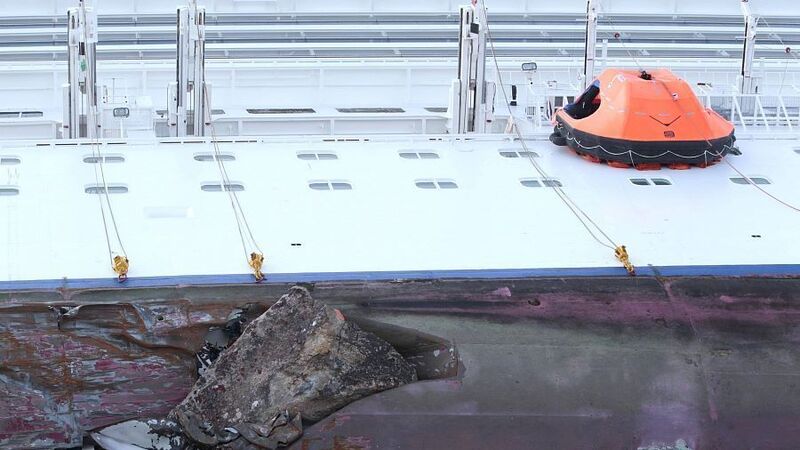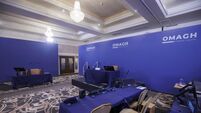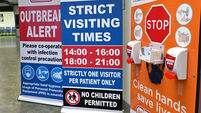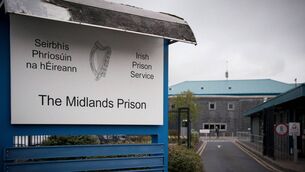Irish couple thought they 'were going to die' on stricken liner

An Irish couple who were on board the stricken cruise ship that ran aground off the Italian coast have described the terror that unfolded as the liner keeled over.
The Department of Foreign Affairs said the man and woman were the only Irish citizens it is aware of who were passengers on the Costa Concordia.
At least three people died in the accident near the Tuscan holiday island of Giglio last night.
Two French passengers and a Peruvian crewman died in the accident, the Italian news agency ANSA reported.
The vessel, which was carrying more than 4,000 passengers, ran aground and keeled over after apparently sailing off course.
The couple – Seamus and Carol Moore from Clonmel, Co Tipperary – who took the cruise to celebrate a birthday, spent two-and-a-half hours on deck before being rescued.
“The staff did their best to advise us in terms of going out one by one but of course there was total panic, so there was a melee and people clambering over other people rather than just taking their time,” said Mr Moore.
“Eventually everybody got out or was got out. I had to climb out and get on top of the lifeboat and from there had to climb onto what was the lifeboat deck and at that stage the ship was listing very badly so we were advised to move to the front of the ship, which we did, lights were going on and off.”
Retired Mr Moore said he thought he and his wife were going to die.
“Older people found it very difficult,” he told broadcaster RTE.
“They couldn’t keep their footing and slipped.”
Divers are searching the submerged half of the cruise ship for around 70 people still missing.
A coast guard official said the missing might be trapped “in the belly of the ship”.
Capt. Cosimo Nicastro said tonight there were no firm indications that any one was trapped on the Costa Concordia.
But he noted that rescuers carried out an extensive search of the waters near the ship for hours and “we would have seen bodies”.
He said “the place where they might be is in the belly of the ship”.
Three bodies were recovered after the cruise ship with more than 4,200 people aboard ran aground off the tiny island of Giglio off Tuscany late last night.
The accident tore a 160-ft (50-metre) gash in its hull allowing the sea to rush in.
Survivors who escaped the ship said they crawled along upended hallways trying to reach safety as plates and glasses crashed.
Passengers described a scene reminiscent of Titanic, complaining the crew failed to give instructions on how to evacuate and once the emergency became clear, delayed lowering the lifeboats until the ship was listing too heavily for many of them to be released.
Authorities have been checking names against the passenger list, but have had a hard time accounting for everyone.
Helicopters whisked some to safety, some survivors were rescued by private boats in the area, and witnesses said some people jumped from the ship into the dark, cold sea.
By this morning, the ship was lying virtually flat off Gigio’s coast, its starboard side submerged in the water and the huge gash showing clearly on its upturned hull.
Authorities still had not counted all the survivors by the time they reached mainland 12 hours later.
The evacuation drill was only scheduled for Saturday afternoon, even though some passengers had already been on board for several days.
“It was so unorganised, our evacuation drill was scheduled for 5 pm,” said American Melissa Goduti, 28, of Connecticut, who had set out on the cruise of the Mediterranean hours earlier. “We had joked ’What if something had happened today?”’
“Have you seen ’Titanic?’ That’s exactly what it was,” said Valerie Ananias, 31, a schoolteacher from Los Angeles who was travelling with her sister and parents on the first of two cruises around the Mediterranean.
They all bore dark red bruises on their knees from the desperate crawl they endured along nearly vertical hallways and stairwells, trying to reach rescue boats.
“We were crawling up a hallway, in the dark, with only the light from the life vest strobe flashing,” her mother, Georgia Ananias, 61 said. “We could hear plates and dishes crashing, people slamming against walls.”
She choked up as she recounted the moment when an Argentine couple handed her their three-year-old daughter, unable to keep their balance as the ship lurched to the side and the family found themselves standing on a wall.
“He said ’take my baby,”’ Mrs Ananias said, covering her mouth with her hand as tears welled up.
“I grabbed the baby. But then I was being pushed down. I didn’t want the baby to fall down the stairs. I gave the baby back. I couldn’t hold her.
“I thought that was the end and I thought they should be with their baby,” she said.
“I wonder where they are,” daughter Valerie whispered.
The family said they were some of the last off the ship, forced to shimmy along a rope down the exposed side of the ship to a waiting rescue vessel below.
Survivor Christine Hammer, from Bonn, Germany, shivered near the harbour of Porto Santo Stefano, on the mainland, after stepping off a ferry from Giglio.
She was wearing elegant dinner clothes – a gray cashmere sweater, a silk scarf - along with a large pair of hiking boots, which a kind islander gave her after she lost her shoes in the scramble to escape. Left behind in her cabin were her passport, credit cards and phone.
Hammer, 65, said she was eating her first course, an appetiser of cuttlefish, sauteed mushrooms and salad, on her first night aboard her first-ever cruise, which was a gift to her and her husband, Gert, from her local church where she volunteers.
Suddenly, “we heard a crash. Glasses and plates fell down and we went out of the dining room and we were told it wasn’t anything dangerous,” she said.
Several passengers agreed, saying crew members for a good 45 minutes told passengers there was a simple “technical problem” that had caused the lights to go off. Seasoned cruisers, however, knew better and went to get their life jackets from their cabins and report to their “muster stations,” the emergency stations each passenger is assigned to, they said.
Once there, though, crew members delayed lowering the lifeboats even thought the ship was listing badly, they said.
“We had to scream at the controllers to release the boats from the side,” said Mike van Dijk, a 54-year-old from Pretoria, South Africa. “We were standing in the corridors and they weren’t allowing us to get onto the boats. It was a scramble, an absolute scramble.”
Passengers Alan and Laurie Willits from Wingham, Ontario, celebrating their 30th wedding anniversary, said they were watching the magic show in the ship’s main theatre when they felt an initial lurch, as if from a severe steering manoeuvre, followed a few seconds later by a “shudder” that tipped rubbish bins over. The subsequent listing of the ship made the theatre curtains seem like they were standing on their side.
“And then the magician disappeared,” Laurie Willits said, saying the magician left the stage and panicked audience members fled for their cabins as well.
Once at their life boat station, crew members directed passengers to go upstairs from the fourth floor deck; Alan Willits said he refused.
“I said ’no this isn’t right.’ And I came out and I argued ’When you get this boat stabilised, I’ll go up to the fifth floor then,” he said. Eventually, his lifeboat was lowered down.
But things didn’t improve for passengers once aboard the lifeboats or on land.
“No one counted us, neither in the life boats nor on land,” said Ophelie Gondelle, 28, a French military officer from Marseille. She said there had been no evacuation drill since she boarded in Marseille, France on January 8.
A top Costa executive, Gianni Onorato, said on Giglio the Concordia’s captain had the liner on its regular, weekly route when it struck a reef.
“The ship was doing what it does 52 times a year, going along the route between Civitavecchia and Savona,” a shaken-looking Onorato, who is Costa’s director general, told reporters. The captain is an 11-year Costa veteran, he said.
He said Costa was co-operating with Italian investigators to find out what went wrong.
Some 30 people were reported injured, most of them suffering only bruises, but at least two people were reported in grave condition. Several passengers came off the ferries on stretchers, but it appeared more out of exhaustion and shock than serious injury.
Some passengers, apparently in panic, had jumped off the boat into the sea, witnesses said. Authorities were trying to obtain a full passenger and crew list from Costa, so they could do a roll call to determine who might be missing.
The evacuees were taking refuge in schools, hotels, and a church on the tiny island of Giglio, a popular holiday isle about 18 miles (25 kms) off Italy’s central west coast. Some were evacuated to the port of Porto Santo Stefano on the nearby mainland.
Passengers sat dazed in a middle school opened for them, wrapped in wool or aluminium blankets, with some wearing their life preservers and their shoeless feet covered with aluminium foil. Civil protection crews served them warm tea and bread, but confusion reigned supreme as passengers tried desperately to find the right bus to begin their journey home.
Tanja Berto, from Ebenfurth, Austria, was shuttled from one line to another with her mother and two-year-old son Bruno, trying to figure out how to get back to Savona, where they began their cruise a week ago.
“It’s his birthday today,” she said of her son, rolling her eyes as she held Bruno and tended to her mother, who had grown faint and was lying on the ground. “Happy birthday, Bruno.”
Survivors far outnumbered Giglio’s 1,500 residents, and island Mayor Sergio Ortelli issued an appeal for islanders – “anyone with a roof” – to open their homes to shelter the evacuees.
Paolillo said the exact circumstances of the accident were still unclear, but that the first alarm went off about 10:30 pm, about three hours after the Concordia had begun its voyage from the port of Civitavecchia, en route to its first port of call, Savona, in northwestern Italy.
The coast guard official, speaking from the port captain’s office in the Tuscan port of Livorno, said the vessel “hit an obstacle” – it was not clear if it might have hit a rocky reef in the waters off Giglio – “ripping a gash 50 metres (160 ft) across” in the side of the ship, and started taking on water.
The cruise liner’s captain, Paolillo said, then tried to steer his ship toward shallow waters, near Giglio’s small port, to make evacuation by lifeboat easier. But after the ship started listing badly, lifeboat evacuation was no longer feasible, Paolillo said.
Five helicopters, from the coast guard, navy and air force, were taking turns airlifting survivors still aboard and ferrying them to safety. A coast guard member was airlifted aboard the vessel to help people get aboard a small basket so they could be hoisted up to the helicopter, said Capt Cosimo Nicastro, another Coast Guard official.
Costa Cruises said the Costa Concordia was sailing on a cruise across the Mediterranean Sea, starting from Civitavecchia with scheduled calls to Savona, Marseille, Barcelona, Palma de Mallorca, Cagliari and Palermo.
It said about 1,000 Italian passengers were onboard, as well as more than 500 Germans, about 160 French and about 1,000 crew members.
The Concordia had a previous accident in Italian waters, ANSA reported. In 2008, when strong winds buffeted Palermo, the cruise ship banged against the Sicilian port’s dock, and suffered damage but no one was injured.












